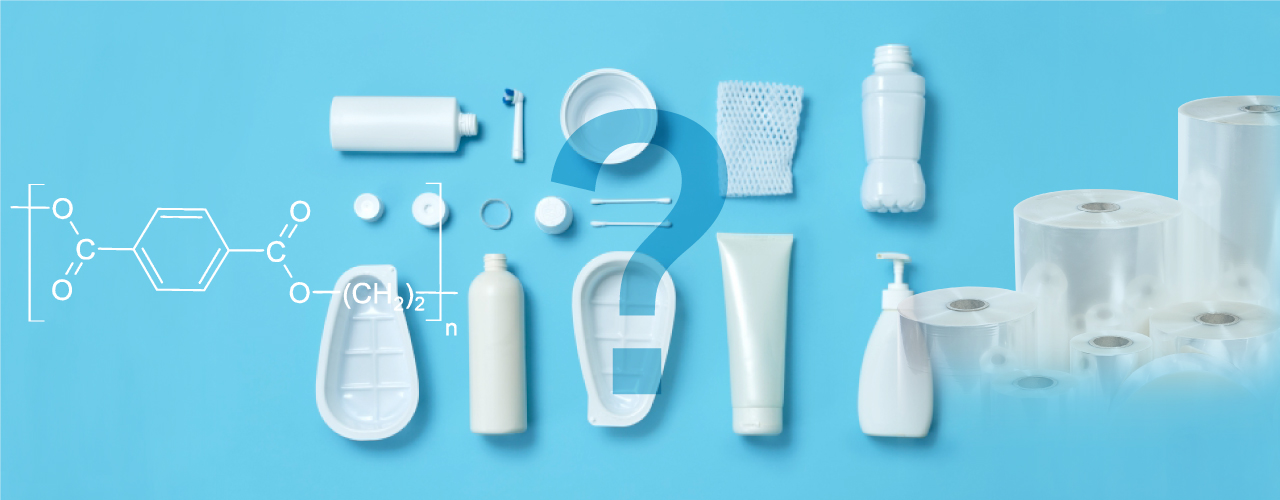Articles on PET resin
What is PET?

Plastic bottles are made of a material called polyethylene terephthalate. It is commonly referred to by its abbreviation, PET. Since PET was first produced in 1941 in the UK, it has been used for a wide variety of purposes, such as synthetic fibers and plastic bottles. PET is mainly made of carbon, oxygen, and hydrogen. It is said to be less dependent on petroleum than other types of plastic as oxygen occupies 1/3 of PET. Also, due to the high content of oxygen, which is heavier than carbon, PET is higher in density than water and therefore sinks in water. PET is a type of resin generally known to have high transparency, high dimensional stability, and high mechanical strength.
Various uses of PET

Synthetic polymer materials, represented by synthetic resins (plastics) such as PET, have excellent mechanical characteristics, are light in weight, easy to mold, and resistant to rust. Due to these features, these materials have been widely used in society as structural materials and functional materials.
PET has been used in all areas of industry, including beverages, packaging for cosmetic products, films and magnetic tapes, and fibers.
In recent years, the characteristics of PET were utilized in products such as partitions to prevent the spread of droplets, used in response to the COVID-19 pandemic across the world.
Examples of use
-

- Plastic bottles
-

- Household appliance parts
-

- Food packaging
-

- Packaging and Stationeries
-

- partitions
What is the difference between A-PET and G-PET?

PET, which is used for increasingly diverse purposes due to its high transparency, tenacity, rigidity, and heat resistance, has taken a long time to be used widely as molding materials, unlike commodity resin. This was due to issues with the crystallization rate.
For this reason, research was conducted on the processing method, which yielded A-PET as well as the improved version G-PET.
A-PET(amorphous polyethylene terephthalate)
A-PET refers to amorphous, non-crystallized PET. It is characterized by its high impact strength, ease in processing by bending, as well as softness and flexibility. However, A-PET was associated with issues such as decreased flexibility, impact resistance, and strength due to the change in crystal conditions with prolonged use and thermal history.
G-PET(glycol-modified polyethylene terephthalate)
Products using thick normal PET resin cool down slowly, which leads to crystallization and causes opacity and deterioration in appearance. However, since the raw materials of G-PET prevent crystallization, G-PET is commonly used in clear thick molded products as it allows for the production of highly transparent, glass-like products. G-PET is superior to A-PET from the viewpoint of impact resistance and molding properties.
Continuous evolution in catalyst technology

PET resin is utilized primarily due to its high transparency and stability of quality. The polymerization catalyst plays an important role, so a high purity product can be obtained in the polycondensation process. A lot of research and improvements are being made in this area. Here, we will introduce two types of catalysts, which are antimony catalysts and titanium catalysts.
Antimony catalysts
Antimony catalysts, represented by antimony trioxide, are used to produce many polyesters globally due to the satisfactory catalyst activity and low cost. However, issues such as productivity during processing and transparency have been identified for this type of catalyst.
Titanium catalysts
Titanium catalysts have high catalyst activity among the existing catalysts and only require a small amount to be used in many cases. It is also considered environmentally friendly due to the small amount of metal residue during incineration. Although titanium catalysts have been associated with issues such as the thermal stability of polymers and yellowing, transparency has been improved by the adjustment of activities and other means.
- Summary
- Plastic bottle made from polyethylene terephthalate (PET). Uniform shape that is easily transported and carried around. PET allowed efficient distribution in a large quantity, which played a major role in the revolution of product distribution along with the reduction of fuel during transport. However, it is increasingly important nowadays to use plastics appropriately with careful consideration for their strengths and weaknesses due to the various issues associated with plastics.
- Author of this article
- Eishi MoritaCEO of TSUKASA PETCO CORPORATION, contributing to the global environment and customers through PET resin and chemicals
